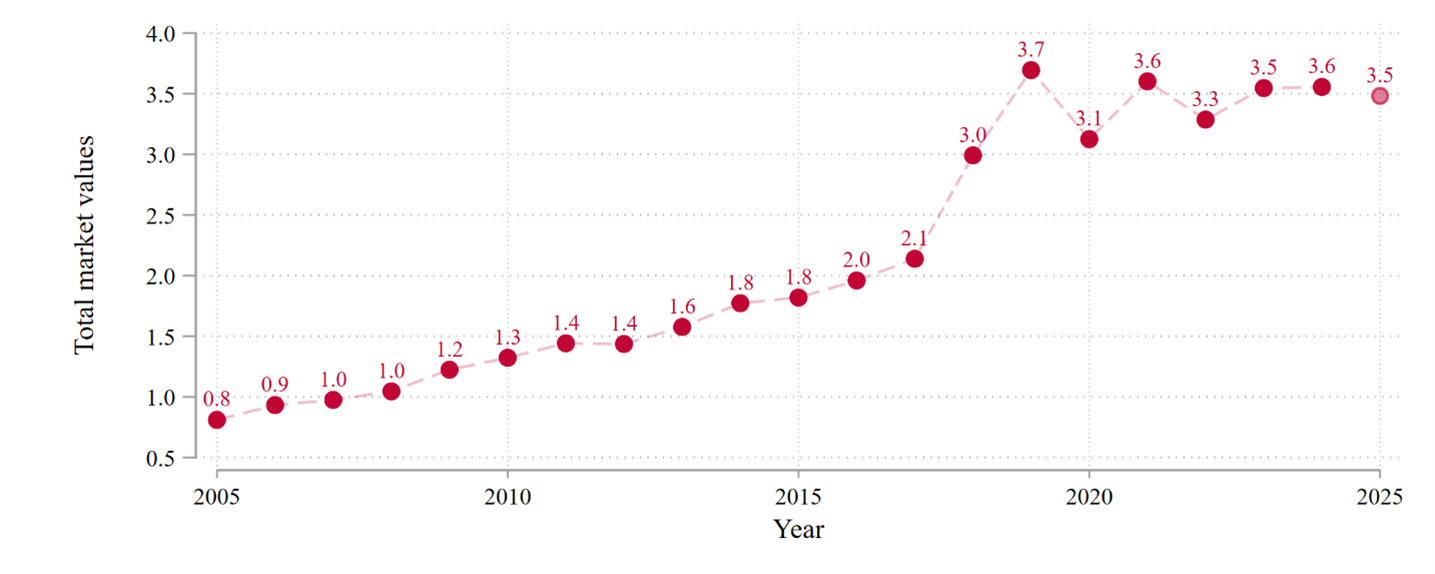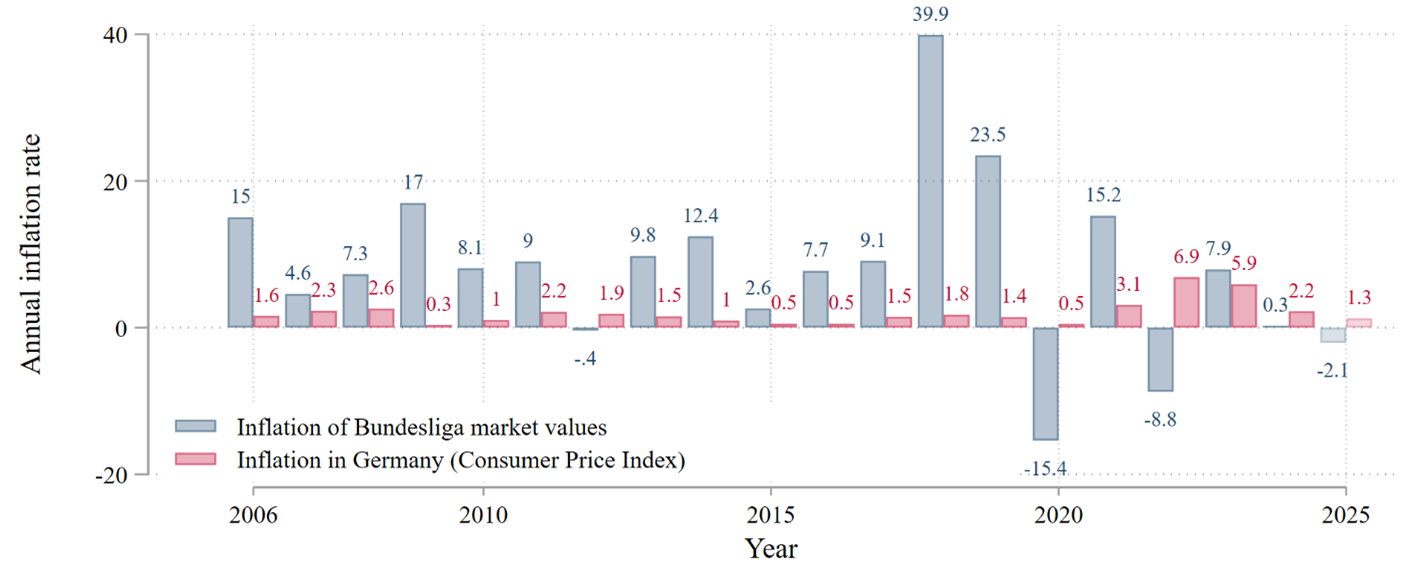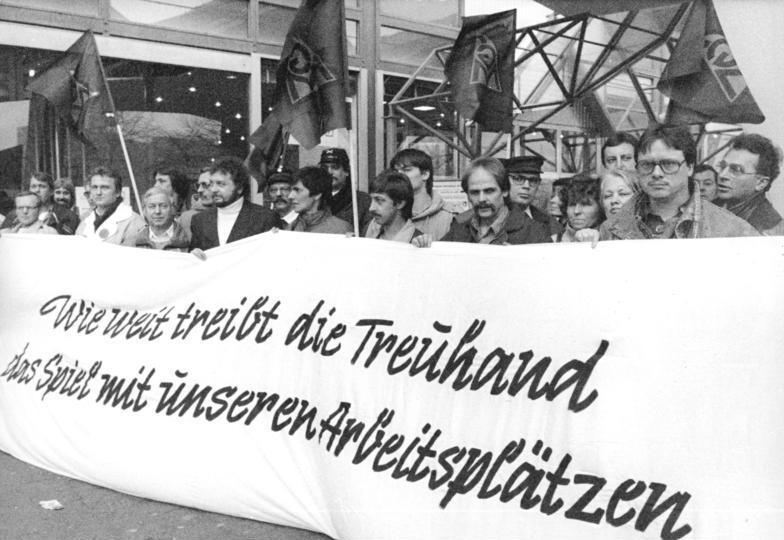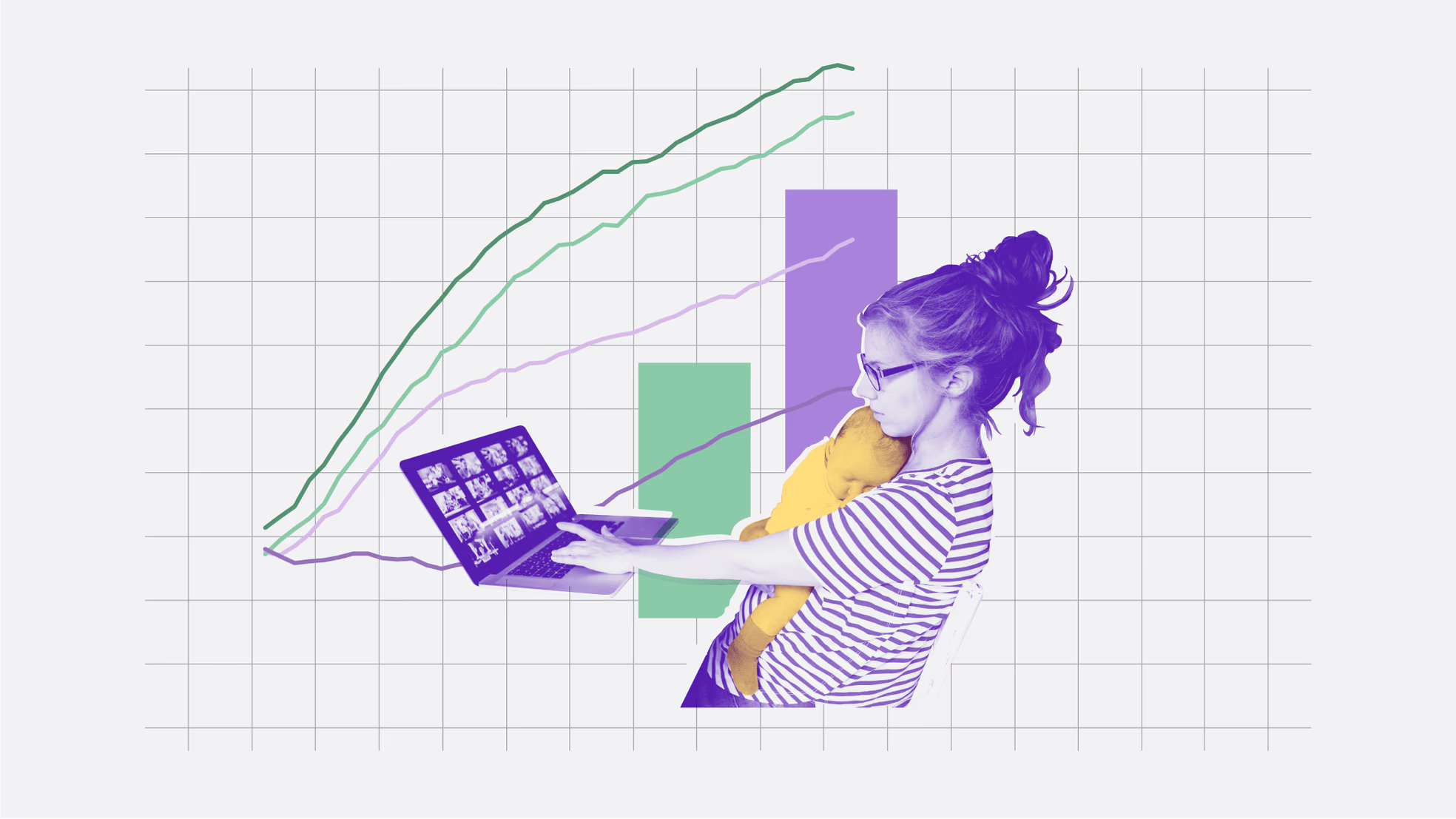Authors
Lukas Tohoff
(ROCKWOOL Foundation Berlin)
Mario Mechtel
(Leuphana University Lüneburg)
While market values in professional soccer had surged over the past two decades, recent years have seen a marked stagnation. This report calculates inflation rates for soccer players’ market values in the German Bundesliga. It finds that, since 2020, market value inflation has essentially halted – contrasting sharply with the strong growth of previous years with inflation rates above 30 percent. Market values in the Bundesliga have therefore developed in exactly the opposite way to consumer prices, which were relatively stable until 2020 and have been rising since then, even though price jumps in football are much larger.
We define market value inflation rates as the percentage change in an aggregate of players’ market values over the period of one year. To calculate the inflation rate, we define a consistent player basket – a comparison group inspired by the basket of goods used to calculate the inflation rate in consumer prices. This player basket is composed of the 11 most expensive players from each of the 18 Bundesliga clubs, yielding a stable sample of 198 players per year. This methodology ensures comparability and minimizes distortions in total market value calculations over time. All results for market value inflation therefore refer to the aggregate market values of this player basket, not to total or average market values of all Bundesliga players, which are influenced by various factors such as varying team sizes. All market values, sourced from transfermarkt.de and measured in EUR, refer to the end of the season before transfers took place.
FIGURE 1: Development of Market values in the Bundesliga, 2005-2025, in billion EUR

Note: The total market values (in billion EUR) are based on a comparison group of 198 players: the 11 most valuable players from each of the 18 Bundesliga teams of each year. All market values (from transfermarkt.de, in EUR) refer to the end of the season. The values for 2025 refer to the end of March 2025.
Figure 1 plots total market values of the 198-player basket for the years 2005 to 2025. It shows that total market values grew steadily between 2005 and 2017, then rose sharply for two years, and after some fluctuations during the Covid-19 pandemic stabilized in the last years. In the last five years, the 198-player basket remained at a total of around 3.5 billion EUR, or 17.7 million EUR per player.
Figure 2 plots annual inflation rates of Bundesliga market values and consumer prices in Germany between 2005 and 2025. It shows that market value inflation rates were consistently positive between 2005 and 2019, except for 2012, where inflation was essentially zero. Market value inflation far exceeded consumer price increases, hovering around 10 percent for many years. In 2018, market values in the Bundesliga increased by almost 40 percent and another 23 percent in the following year. During these years, revenue from television rights rose sharply, from €673 million per season in 2016/17 to €1,159 million in 2017/2018 and subsequent years. Since 2020, which marks the onset of the Covid-19 pandemic, prices have stopped growing. A deflation of 15.4% in 2020 was corrected with inflation of 15.2 percent in 2021. In the following years, the inflation rate was sometimes positive, sometimes negative, without showing a clear trend.
FIGURE 2: Annual Inflation in the Bundesliga and in Germany, 2005-2025, in percent

Note: The inflation of Bundesliga market values is based on a comparison group of 198 players: the 11 most valuable players from each of the 18 Bundesliga teams of each year. All market values (from transfermarkt.de, in euros) refer to the end of the season. The inflation rate in Germany is based on calculations by the Federal Statistical Office. The values for 2025 refer to the end of March 2025.
The reasons for trends in market value inflation are not the primary focus of this report, and any conclusions in that regard remain speculative. Potential explanations may include long-term effects of the COVID-19 pandemic, stagnating television revenues after the sharp increase from 2016/2017 to 2017/18, the transfer of top players abroad, the international performance by Bundesliga clubs, structural changes in league composition with traditionally stronger clubs being relegated, or increased competition from other sports and entertainment industries.
The calculation of market value inflation originated as a byproduct of our research into talent selection in German youth football academies (Tohoff and Mechtel 2025, Journal of Sports Economics). In that study, we demonstrate how clubs systematically overlook long-term potential by favoring youth players born earlier in the calendar year– who appear more physically developed during adolescence, but whose early advantages fade over time. We are the first to translate this issue in talent selection – known as the relative age effect – into market values. We find that clubs could generate 30.6 to 72.8 percent higher market values when eliminating the relative age effect in talent selection. To enable cross-temporal comparisons of player valuation in that context, an inflation-adjusted market value index was required. Since our original study only covers the period up to 2020, we have extended the time series of market value inflation rates until 2025 for this report – the result: contrary to popular belief, market values in the Bundesliga are not constantly on the rise.
References
For further information please refer to our original study:
Tohoff, L., & Mechtel, M. (2025). Fading Shooting Stars—The Relative Age Effect, Ability, and Foregone Market Values in German Elite Youth Soccer. Journal of Sports Economics, 0(0). https://doi.org/10.1177/15270025251320958






